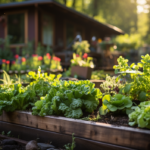Table of Contents
From Frequency to Timing: Discover the Best Practices for Properly Watering Your Vegetable Garden for Optimal Growth and Yield
Growing vegetables in your garden can be a fun and rewarding experience. But if you want to see your plants thrive and produce juicy, flavorful fruits and vegetables, you need to make sure you give them the right amount of water. With the right watering techniques, you can ensure that your vegetable garden stays healthy and produces a bountiful harvest throughout the growing season.
In this article, we will share some of the top tips for watering your vegetable garden like a pro. You’ll learn about the best times to water your plants, how to adjust your watering schedule based on the weather, and the best techniques for delivering water to your plants’ roots. We’ll also cover what tools you’ll need to make watering your garden easy and efficient.
Whether you’re an experienced gardener or just starting out, this guide is sure to help you keep your vegetable garden thriving and producing delicious, healthy crops all season long. So let’s get started!
Watering Frequency: How Often Should You Water Your Vegetable Garden?
Watering your vegetable garden too frequently or not enough can lead to stunted growth or even kill plants if they don’t receive enough moisture. Here are some tips to determine how often you should water your garden:
- Check the soil: Stick your finger into the soil to about an inch deep. If the soil feels dry at this depth, it’s time to water your plants.
- Observe the weather: Plants need more water during the summer or on particularly hot or dry days. Make sure to increase watering frequency on these days.
- Consider plant type: Different types of vegetables have different water needs. For example, leafy greens need more frequent watering than root vegetables.
- Mulching: Mulch can help retain moisture in the soil, reducing the frequency of watering.
It’s important to keep in mind that overwatering can also be harmful to plants. If the soil becomes waterlogged, the roots may rot and fail to absorb necessary nutrients.
One way to make sure you’re giving your plants the right amount of water is by installing a moisture meter. These devices measure how much moisture is in the soil and can help ensure you’re not under or overwatering.
The frequency of watering can also depend on the type of soil you have. Sandy soil drains quickly, and you may need to water more frequently. Clay soil, on the other hand, retains moisture longer, so you may need to water less frequently.
In general, most vegetable gardens will need to be watered about one inch per week. If your area is experiencing an extended period of drought, you may need to increase the watering frequency to keep your plants healthy.
By monitoring the soil’s moisture level, plant types, weather conditions, and soil drainage, you’ll be able to find the right watering frequency to ensure your vegetables thrive.
The Best Time of Day to Water Your Plants
It’s not just about how often you water your plants, but also when you water them. Here are some tips on the best times of day to water your vegetable garden:
- Early morning: Watering in the early morning allows plants to get the most out of the water they receive. The sun isn’t as strong yet, so the plants have plenty of time to absorb the water before it evaporates.
- Late afternoon: If you can’t water in the morning, late afternoon is another good time. The intensity of the sun is beginning to wane, and the water can help cool the soil and plants after a hot day.
- Avoid midday watering: Watering during the middle of the day, when the sun is the strongest, can result in a lot of water evaporating before it reaches the plants. This makes midday watering very inefficient and can lead to water waste.
Watering at night can cause problems like fungus and plant diseases, as the moisture has a hard time evaporating and can lead to waterlogged soil.
It’s also important to avoid getting water on the leaves of your plants, as this can lead to sunscald when the water droplets magnify the sun’s rays. Using a soaker hose or drip irrigation system can help prevent this issue.
Keep in mind that the best time to water your plants can vary depending on the climate and weather in your area. Be sure to observe your plants and adjust your watering schedule accordingly.
By watering your plants at the optimal time of day along with the right amount of water, you’ll be able to help them grow healthy and strong.
Responding to Weather: Adjusting Your Watering Schedule Based on Rain and Heat
Weather plays a major role in the watering needs of your vegetable garden. Here are some tips to adjust your watering schedule based on rain and heat:
- Rain: If you live in an area that receives frequent rain, you may not need to water your garden as often. Make sure to check the soil’s moisture levels to determine if additional watering is needed.
- Heat: During hot weather, plants need more water as the heat causes the moisture in the soil to evaporate more quickly. Make sure to increase your watering frequency on these hot days.
- Dry spells: Extended periods of dry weather can be detrimental to plants and can lead to wilting and death. Adjust your watering schedule to increase the frequency of watering during dry spells.
- Water conservation: In areas where water is scarce or during times of drought, it’s important to be mindful of water use and conservation. You can use rain barrels or collect water from other sources to help offset the need for tap water.
It’s also important to pay attention to your garden’s unique needs. Certain plants, like tomatoes, require consistent watering to avoid cracking or splitting. Other plants, like carrots, can handle drier conditions.
One way to help conserve water is to use mulch, which helps retain moisture in the soil. Using a layer of two to three inches of mulch around your plants can prevent the soil from drying out too quickly.
Keep in mind that watering may need to be adjusted based on various factors such as the type of soil you have, the stage of growth of your plants, or the amount of sun the garden is receiving.
By adjusting your watering schedule based on the weather and the specific needs of your garden, you can help your plants thrive and produce a bountiful harvest.
Techniques for Delivering Water to Your Plants’ Roots
It’s not just about the amount or frequency of watering, but also about how you deliver the water to your plants. Here are some techniques to ensure water reaches your plants’ roots:
- Soaker hoses: Soaker hoses can deliver water directly to the soil and avoid getting water on the leaves, which can lead to sunscald. The slow, steady output of water allows the soil to absorb the water gradually.
- Drip irrigation: Drip irrigation systems are another way of delivering water directly to the soil. These systems use tubing that delivers water drop by drop to each individual plant.
- Watering cans: Watering cans are a simple and effective way of getting water directly to the base of the plant. Make sure to avoid getting water on the leaves.
- Sprinklers: Sprinklers can be an efficient way of watering large areas but can lead to water waste if not adjusted properly. Make sure to adjust the sprinkler so that it waters the soil and not the leaves or air.
- Hand watering: Hand watering is a great way to apply water directly to the soil where it’s needed, but can be time-consuming. Be careful not to disturb the soil around your plants too much when watering.
When watering your plants, it’s important to make sure the water is reaching the soil and not just the surface. The first few inches of soil are the most important for plant growth.
No matter which method of delivery you choose, make sure to water thoroughly. A good soaking once a week is better than a little bit of water every day. This will encourage your plants to grow deep roots, which will help them access water and nutrients more efficiently.
It’s also important to make sure you’re delivering the right amount of water. Too much water can lead to waterlogged soil and root rot, while too little can lead to drying out of the soil.
By using the right techniques to deliver water to your plants’ roots, you can help your plants grow strong and healthy and produce a bountiful harvest.
Conclusion
Whether you’re a seasoned gardener or just starting out, watering your vegetable garden properly is essential for the success of your plants. With the right frequency, timing, and techniques, you can ensure that your garden produces a bountiful harvest of delicious and nutritious vegetables. From checking the soil moisture to adjusting your schedule based on weather patterns, these top tips for watering your vegetable garden will help keep your plants healthy and happy. Remember, overwatering can be just as harmful as underwatering, so be mindful of your garden’s individual needs and adjust accordingly. By following these tips, you’ll be on your way to a successful vegetable garden that will provide you with fresh produce all season long.









